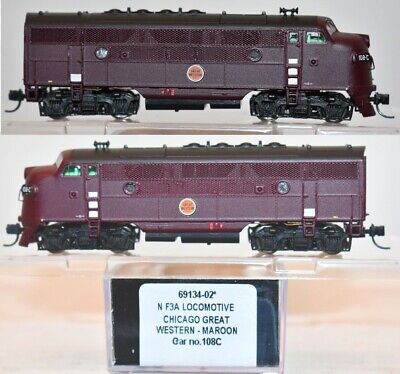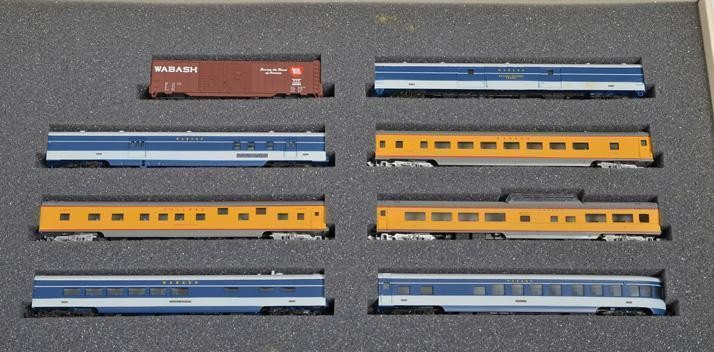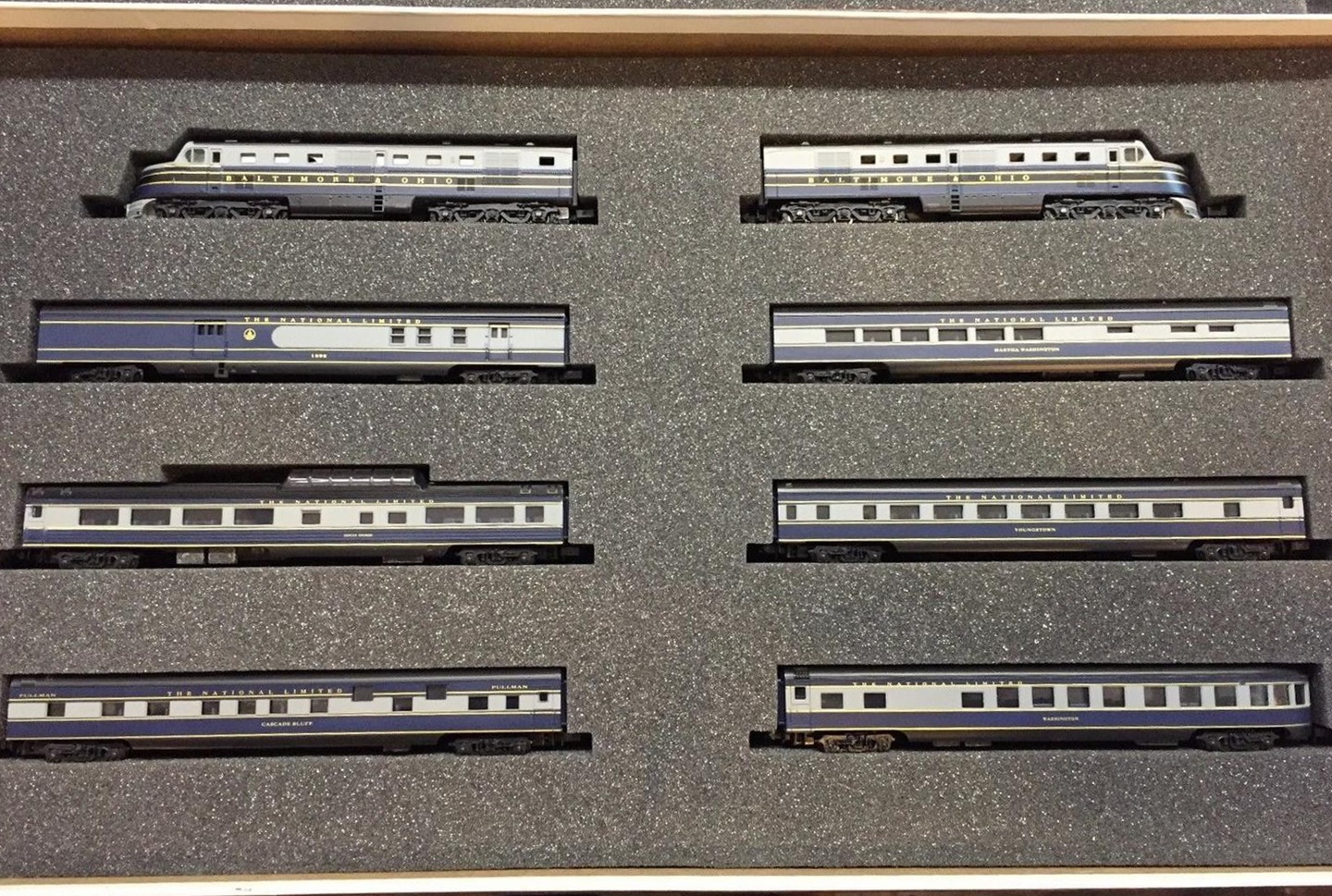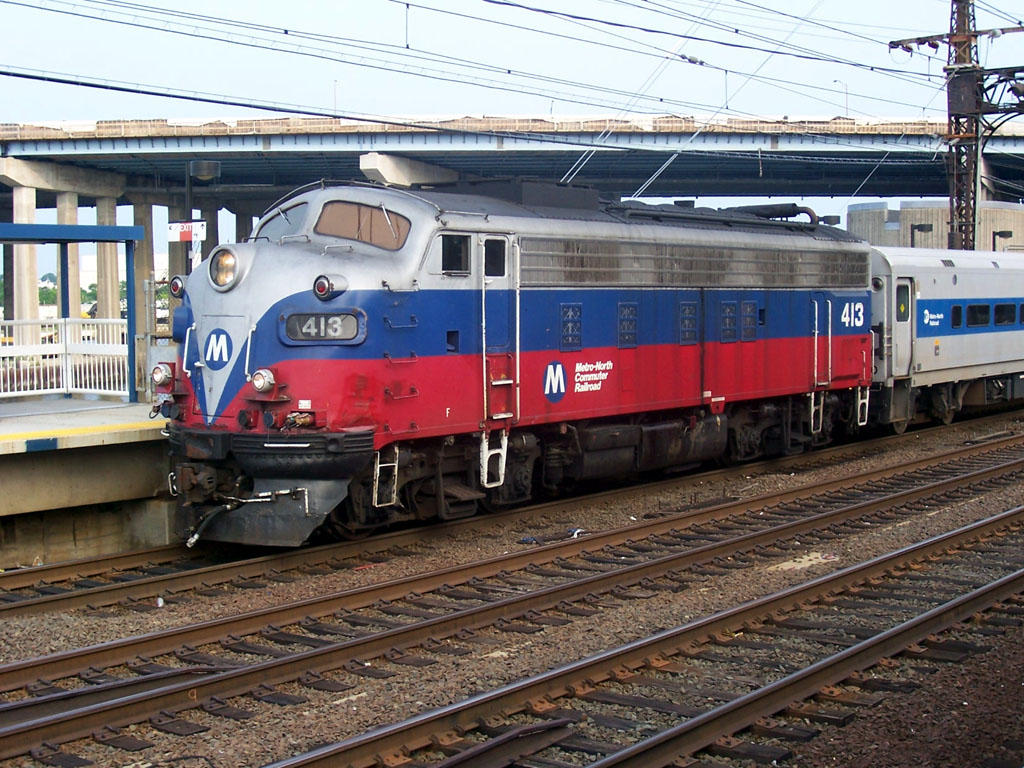Model Information: InterMountain introduced this model in 2005, and have since followed up with several subsequent runs. The model shares the same chassis as Intermountain's F7s. The PC board was re-designed in 2014 with motor contact "shoes" replaced by wires.
In December 2014, a new run of several road numbers was announced which introduced new factory DCC-equipped versions, sound and non-sound. These models come with a brand new design that incurred significant delays. First batch is expected to be delivered mid-2017.
These locos sport all of the niceties one normally associates with "modern" diesel models, e.g. - split-frame DCC-Ready metal chassis, dual-flywheels, low-friction drive, plastic truck assemblies, plastic gearing, blackened wheels, all-wheel drive / pick-up (no traction tires). The motor is an open-sided 5-poler. Directional lighting on A units is controlled by a PC board mounted on top of the chassis, and with the LED headlight mounted on the front of the chassis (with wires running between the two).
In December 2014, a new run of several road numbers was announced which introduced new factory DCC-equipped versions, sound and non-sound. These models come with a brand new design that incurred significant delays. First batch is expected to be delivered mid-2017.
These locos sport all of the niceties one normally associates with "modern" diesel models, e.g. - split-frame DCC-Ready metal chassis, dual-flywheels, low-friction drive, plastic truck assemblies, plastic gearing, blackened wheels, all-wheel drive / pick-up (no traction tires). The motor is an open-sided 5-poler. Directional lighting on A units is controlled by a PC board mounted on top of the chassis, and with the LED headlight mounted on the front of the chassis (with wires running between the two).
DCC Information:
Models released up to 2014: These locos are qualified as "DCC-Friendly" and not "Ready" because installing after-market decoders requires de-soldering and re-soldering a few wires. Not too complex, but you'll need a soldering iron...
- For locos released before 2014: front light of A units needs to be re-soldered to the decoder board.
- For locos released after 2014: in addition to the front light, the motor contacts are performed by two wires that need to be re-soldered to the decoder board.
Accepts the following decoders (non-sound):
- Digitrax DN163I1C: 1.5 Amp N Scale Mobile Decoder for Intermountain F3 / F7 Units. (discontinued)
- Digitrax DN166I1C: 1.5 Amp Decoder for Intermountain N scale F3 and F7 A & B units with motor contact "shoes".
- Digitrax DN166I1D: 1.5 Amp Decoder for InterMountain N Scale F7A & B units with wired motors produced after Jan 2014.
- TCS IMF4: 4 Function Decoder for Intermountain F3A/B, F7A/B and F9B N-Scale locomotives. (Installation for Intermountain F3A)
- TCS IMF4-NF: 4 Function Decoder for Intermountain F3A/B, F7A/B and F9B N-Scale locomotives produced after Jan 2014. (Installation for Intermountain F7A)
Models released as of 2017: this model is proposed factory-equipped with either a non-sound DCC decoder (models suffixed by "D") or a sound DCC decoder (models suffixed by "S"), both from ESU - LokSound Select Micro or LokPilot Micro.
Models released up to 2014: These locos are qualified as "DCC-Friendly" and not "Ready" because installing after-market decoders requires de-soldering and re-soldering a few wires. Not too complex, but you'll need a soldering iron...
- For locos released before 2014: front light of A units needs to be re-soldered to the decoder board.
- For locos released after 2014: in addition to the front light, the motor contacts are performed by two wires that need to be re-soldered to the decoder board.
Accepts the following decoders (non-sound):
- Digitrax DN163I1C: 1.5 Amp N Scale Mobile Decoder for Intermountain F3 / F7 Units. (discontinued)
- Digitrax DN166I1C: 1.5 Amp Decoder for Intermountain N scale F3 and F7 A & B units with motor contact "shoes".
- Digitrax DN166I1D: 1.5 Amp Decoder for InterMountain N Scale F7A & B units with wired motors produced after Jan 2014.
- TCS IMF4: 4 Function Decoder for Intermountain F3A/B, F7A/B and F9B N-Scale locomotives. (Installation for Intermountain F3A)
- TCS IMF4-NF: 4 Function Decoder for Intermountain F3A/B, F7A/B and F9B N-Scale locomotives produced after Jan 2014. (Installation for Intermountain F7A)
Models released as of 2017: this model is proposed factory-equipped with either a non-sound DCC decoder (models suffixed by "D") or a sound DCC decoder (models suffixed by "S"), both from ESU - LokSound Select Micro or LokPilot Micro.
Prototype History: The EMD F3 was a 1,500-horsepower (1,100 kW) B-B freight- and passenger-hauling diesel locomotive produced between July 1945 and February 1949 by General Motors’ Electro-Motive Division. Final assembly was at GM-EMD's La Grange, Illinois plant. A total of 1,111 cab-equipped lead A units and 696 cabless booster B units were built.
The F3 was the third model in GM-EMD's highly successful F-unit series of cab unit diesel locomotives, and it was the second most produced of the series. The F3 essentially differed from the EMD F2 in that it used the “new” D12 generator to produce more power, and from the later EMD F7 in electrical equipment. Some late-model F3's had the same D27 traction motors, along with the heavier-duty electrical cables, used in the F7, and were referred to as model F5 by EMD's Engineering Department.
From Wikipedia
Read more on American-Rails.com
The F3 was the third model in GM-EMD's highly successful F-unit series of cab unit diesel locomotives, and it was the second most produced of the series. The F3 essentially differed from the EMD F2 in that it used the “new” D12 generator to produce more power, and from the later EMD F7 in electrical equipment. Some late-model F3's had the same D27 traction motors, along with the heavier-duty electrical cables, used in the F7, and were referred to as model F5 by EMD's Engineering Department.
From Wikipedia
Read more on American-Rails.com
Road Name History: 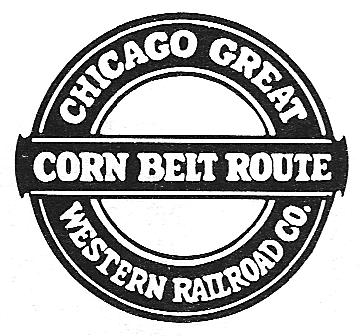 Chicago Great Western was the result of the 1892 reorganization of the Chicago St. Paul & Kansas City. By 1903, the CGW had grown to its maximum size. The CGW had a vaguely cross-shaped system map. The east-west leg started in Chicago and linked Dubuque, Fort Dodge (both in Iowa) and finally Omaha, Nebraska. The north-south line started in St. Paul, Minnesota and linked Waterloo and Des Moines, Iowa then St. Joseph and Kansas City, Missouri. Each axis consisted of a big arc which put CGW at a distance disadvantage to most other railroads servicing the same region – and there were a lot of railroads in the area.
Chicago Great Western was the result of the 1892 reorganization of the Chicago St. Paul & Kansas City. By 1903, the CGW had grown to its maximum size. The CGW had a vaguely cross-shaped system map. The east-west leg started in Chicago and linked Dubuque, Fort Dodge (both in Iowa) and finally Omaha, Nebraska. The north-south line started in St. Paul, Minnesota and linked Waterloo and Des Moines, Iowa then St. Joseph and Kansas City, Missouri. Each axis consisted of a big arc which put CGW at a distance disadvantage to most other railroads servicing the same region – and there were a lot of railroads in the area.
Passenger service was never a major priority and many trains consisted of doodlebugs and trailers even before World War One. In the 1920s CGW did team up with Santa Fe to run through sleepers from the Twin Cities to Los Angeles.
Big mainline power in the 30s and 40s consisted of a fleet of 3 dozen 2-10-4s. In 1936, CGW launched piggyback service – one of the first in the nation. One piggyback customer was a truck line specializing in hauling steel. Since CGW charged by the trailer, the truck line would take the contents of 3 trailers which had maxed out on highway weight and reload all the steel into a single catastrophically heavy trailer that would ride the flat car. They didn’t tell CGW though. No one was the wiser until the landing gear on a trailer punched through the deck of the flat car and derailed a train at speed!
By 1950, CGW had completely dieselized with a mix of Alco, Baldwin and EMD switchers, Alco and EMD road switchers (the former running long hood forward and the latter equipped with dual controls,) and a sizable fleet of EMD F units. By this time, the Deramus family (who already controlled the Kansas City Southern) had gained control of the CGW. Over the years, they cut costs and services. CGW began holding trains until they reached maximum tonnage. Trains between 150 and 250 cars were a daily occurrance behind A-B-B-B-B-A sets of F units. What’s more, these monsters would stop and switch along the way!
Around 1951, they dropped “The Corn Belt Route” logo in favor of the Lucky Strike style logo. The first generation of diesels were delivered in ornate maroon, and red with yellow striping. This was replaced with a simplified solid maroon and then red with black roof (which was essentially the same as neighbor and fellow Deramus controlled Kansas City Southern.) The second generation of diesels consisted entirely of GP30’s and SD40’s.
Despite the iffy service and tremendous competition in the area, and thanks to the cost cutting and a dearth of money losing passenger operations that plagued their neighbors, CGW steadily made money through the 50s and 60s. But, in the age of mergers, it was clear they couldn’t make it on their own. CGW discussed merger with every possible connection but ultimately merged into Chicago & North Western in 1968. In their last full year, the CGW was a 1,411 mile line with 139 locomotives (for comparison, they were about the same size as Western Pacific.)

Passenger service was never a major priority and many trains consisted of doodlebugs and trailers even before World War One. In the 1920s CGW did team up with Santa Fe to run through sleepers from the Twin Cities to Los Angeles.
Big mainline power in the 30s and 40s consisted of a fleet of 3 dozen 2-10-4s. In 1936, CGW launched piggyback service – one of the first in the nation. One piggyback customer was a truck line specializing in hauling steel. Since CGW charged by the trailer, the truck line would take the contents of 3 trailers which had maxed out on highway weight and reload all the steel into a single catastrophically heavy trailer that would ride the flat car. They didn’t tell CGW though. No one was the wiser until the landing gear on a trailer punched through the deck of the flat car and derailed a train at speed!
By 1950, CGW had completely dieselized with a mix of Alco, Baldwin and EMD switchers, Alco and EMD road switchers (the former running long hood forward and the latter equipped with dual controls,) and a sizable fleet of EMD F units. By this time, the Deramus family (who already controlled the Kansas City Southern) had gained control of the CGW. Over the years, they cut costs and services. CGW began holding trains until they reached maximum tonnage. Trains between 150 and 250 cars were a daily occurrance behind A-B-B-B-B-A sets of F units. What’s more, these monsters would stop and switch along the way!
Around 1951, they dropped “The Corn Belt Route” logo in favor of the Lucky Strike style logo. The first generation of diesels were delivered in ornate maroon, and red with yellow striping. This was replaced with a simplified solid maroon and then red with black roof (which was essentially the same as neighbor and fellow Deramus controlled Kansas City Southern.) The second generation of diesels consisted entirely of GP30’s and SD40’s.
Despite the iffy service and tremendous competition in the area, and thanks to the cost cutting and a dearth of money losing passenger operations that plagued their neighbors, CGW steadily made money through the 50s and 60s. But, in the age of mergers, it was clear they couldn’t make it on their own. CGW discussed merger with every possible connection but ultimately merged into Chicago & North Western in 1968. In their last full year, the CGW was a 1,411 mile line with 139 locomotives (for comparison, they were about the same size as Western Pacific.)
Brand/Importer Information: InterMountain was founded in 1985 by Fred Brummet. They got started in the model railroad business by producing O-Scale model kits. They got started in the N Scale business almost a decade later when in 1994 they introduced the 40-23 reefer car in kit form. Later, in 1998, they started producing RTR (Ready-to-Run) models. By the early 2000s, InterMountain phased out kit production in favor of the RTR models.
The InterMountain Railway company is located at 1224 Boston Ave in Longmont, CO. They are a manufacturer of HO, N and Z scale model trains. They have produced kits as well as RTR (Ready-To-Run) models. Their N Scale products include locomotives as well as rolling stock. Their rolling stock lineup includes Boxcars, Hoppers, Tank Cars, Reefers, Gondolas, Stock Cars and Flatcars.
Their locomotive releases have primarily been diesel units, with the one major exception being their series of AC-12 Cab Forward steam locos. Their diesel lineup includes F3's, F7's, F9's, SD40's, SD45's and FT units. They are known for quality and detail. They also release their rolling stock in larger varieties of road numbers than most of the other manufacturers.
The InterMountain Railway company is located at 1224 Boston Ave in Longmont, CO. They are a manufacturer of HO, N and Z scale model trains. They have produced kits as well as RTR (Ready-To-Run) models. Their N Scale products include locomotives as well as rolling stock. Their rolling stock lineup includes Boxcars, Hoppers, Tank Cars, Reefers, Gondolas, Stock Cars and Flatcars.
Their locomotive releases have primarily been diesel units, with the one major exception being their series of AC-12 Cab Forward steam locos. Their diesel lineup includes F3's, F7's, F9's, SD40's, SD45's and FT units. They are known for quality and detail. They also release their rolling stock in larger varieties of road numbers than most of the other manufacturers.
Item created by: dennis.kamper on 2023-03-15 06:57:09. Last edited by dennis.kamper on 2023-03-15 07:00:35
If you see errors or missing data in this entry, please feel free to log in and edit it. Anyone with a Gmail account can log in instantly.
If you see errors or missing data in this entry, please feel free to log in and edit it. Anyone with a Gmail account can log in instantly.


